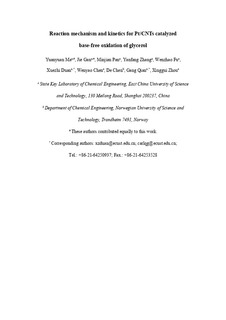| dc.contributor.author | Ma, Yuanyuan | |
| dc.contributor.author | Gan, Jie | |
| dc.contributor.author | Pan, Minjian | |
| dc.contributor.author | Zhang, Yanfang | |
| dc.contributor.author | Fu, Wenzhao | |
| dc.contributor.author | Duan, Xuezhi | |
| dc.contributor.author | Chen, Wenyao | |
| dc.contributor.author | Chen, De | |
| dc.contributor.author | Qian, Gang | |
| dc.contributor.author | Zhou, Xinggui | |
| dc.date.accessioned | 2020-02-07T10:26:49Z | |
| dc.date.available | 2020-02-07T10:26:49Z | |
| dc.date.created | 2019-11-21T15:14:19Z | |
| dc.date.issued | 2019 | |
| dc.identifier.citation | Chemical Engineering Science. 2019, 203 228-236. | nb_NO |
| dc.identifier.issn | 0009-2509 | |
| dc.identifier.uri | http://hdl.handle.net/11250/2640309 | |
| dc.description.abstract | Fundamental understanding of heterogeneously catalyzed aerobic, base-free oxidation of glycerol is highly desirable for sustainable and highly efficient chemical synthesis. In this work, Pt/CNTs catalyzed base-free oxidation of glycerol is investigated by combining experiments, DFT calculations and kinetics analysis. The solvent effects and kinetic isotope effects measurements as well as DFT calculations reveal that water-assisted O2 activation to form active OH∗ intermediates is not in rate-determining step (RDS) but in equilibrium. Then, Langmuir-Hinshelwood kinetic models are developed and fitted with the experimental data. The OH∗-assisted CH bond cleavage of glycerol is discriminated as the RDS for the two parallel oxidation pathways of glycerol via primary or secondary hydroxyl groups, where the former case exhibits lower activation energy. The insights revealed here could guide the design and optimization of this catalytic process to generate the targeted products. | nb_NO |
| dc.language.iso | eng | nb_NO |
| dc.publisher | Elsevier | nb_NO |
| dc.rights | Attribution-NonCommercial-NoDerivatives 4.0 Internasjonal | * |
| dc.rights.uri | http://creativecommons.org/licenses/by-nc-nd/4.0/deed.no | * |
| dc.title | Reaction mechanism and kinetics for Pt/CNTs catalyzed base-free oxidation of glycerol | nb_NO |
| dc.type | Journal article | nb_NO |
| dc.type | Peer reviewed | nb_NO |
| dc.description.version | acceptedVersion | nb_NO |
| dc.source.pagenumber | 228-236 | nb_NO |
| dc.source.volume | 203 | nb_NO |
| dc.source.journal | Chemical Engineering Science | nb_NO |
| dc.identifier.doi | 10.1016/j.ces.2019.03.068 | |
| dc.identifier.cristin | 1750607 | |
| dc.description.localcode | © 2019. This is the authors’ accepted and refereed manuscript to the article. Locked until 29.3.2021 due to copyright restrictions. This manuscript version is made available under the CC-BY-NC-ND 4.0 license http://creativecommons.org/licenses/by-nc-nd/4.0/ | nb_NO |
| cristin.unitcode | 194,66,30,0 | |
| cristin.unitname | Institutt for kjemisk prosessteknologi | |
| cristin.ispublished | true | |
| cristin.fulltext | postprint | |
| cristin.qualitycode | 2 | |

